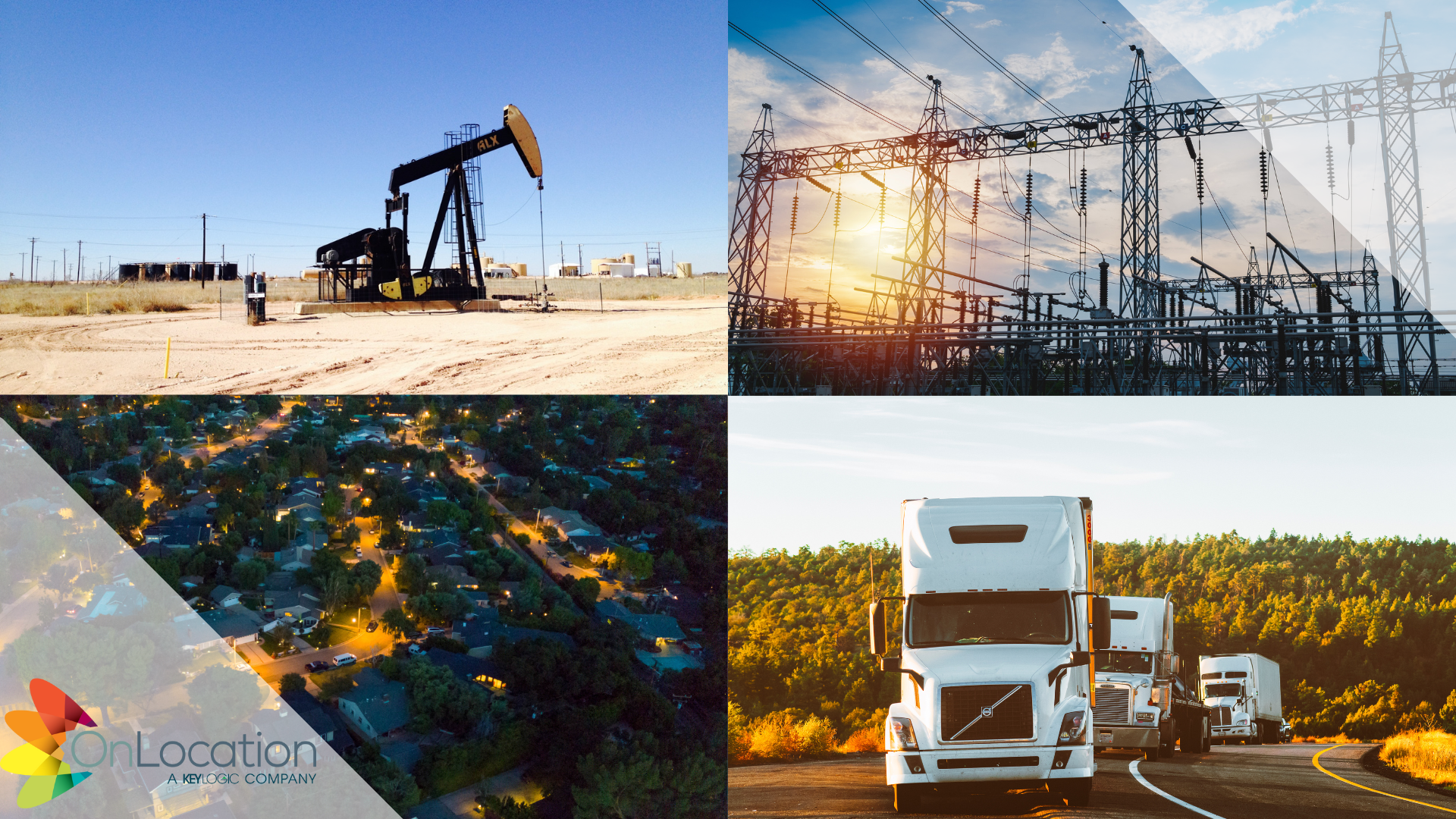
AEO 2025 Trends Wrap-Up: Cross-Sector Insights and Emerging Energy Futures
The U.S. Energy Information Administration’s (EIA) Annual Energy Outlook 2025 (AEO 2025) provides a comprehensive view of potential long-term trends in U.S. energy supply, demand, and emissions through 2050. Released in April 2025, this edition incorporates substantial upgrades to the National Energy Modeling System (NEMS), enhancing EIA’s capacity to simulate evolving energy markets under current and future laws and regulations. In lieu of a traditional narrative report, EIA has emphasized data transparency and model accessibility by publishing detailed interactive tables for the AEO Reference and Side Case scenarios as well as updated documentation of the NEMS model and scenario assumptions online.
At OnLocation, we believe that the value of AEO 2025 lies not only in the richness of its data but also in the insights that come from interpreting the AEO scenarios in context. That’s why we launched our AEO 2025 Trends blog series, which translates scenario results into narratives that highlight key results, underlying drivers, and policy and technological sensitivities across the energy system. OnLocation has decades of experience in the application and enhancement of NEMS for its clients and offers a unique perspective for interpreting the AEO results. This wrap-up article provides a comprehensive overview that brings together findings from across the series and reflects on the broader implications of this year’s release for policymakers, analysts, and energy sector stakeholders.
Explore the AEO 2025 Article Series
Our AEO 2025 Trends articles examine the results and assumptions embedded in EIA’s Reference and Side Case scenarios. These blogs are designed to help government agencies, corporations, and research organizations make sense of key shifts in the projections, particularly where EIA has published detailed modeling output but minimal interpretive commentary.
You can explore the full OnLocation article series here:
🔹 Introduction to the AEO 2025: What’s New and What It Means (April 21): Initial article describing NEMS upgrades, scenario structure, and EIA’s 2025 modeling context as well as a sneak peek at some results focused on electricity demand and supply.
🔌 Electricity Sector: Powering Future Demand (June 4): Analysis of electricity demand drivers, including growing demand from AI data centers, and resulting changes in generation mix. The article focuses on differences in power sector results between AEO cases and the OnLocation Energy Horizons Alternative Policies case.
⚡ Grid and Materials: Grid Reliability and Critical Materials (June 10): Evaluates the growing interdependence between grid reliability and critical mineral demand, using the AEO 2025 projections for utility-scale battery storage technologies. With help from OnLocation’s Critical Materials Module designed for use with the NEMS model, we estimate the amount of lithium and graphite needed to meet this growing demand. The analysis underscores the need to integrate materials planning into long-term grid infrastructure decisions.
🚘 Transportation Sector: Driving Transportation Policy Change (June 18): Comparison of energy demand and technology pathways especially for light-duty vehicles and freight trucks under two distinct regulatory outlooks.
🛢️ Oil & Gas Supply: Hydrocarbon Supply Module and Side Case Impacts (June 24): Focuses on supply model updates, scenario-specific production outcomes, and implications for U.S. energy security.
💻 Commercial Sector: Growing Electricity Demand from Data Centers (July 2): Examines how AEO 2025 represents AI-driven data center loads in commercial electricity consumption projections. Using AEO 2023 as a counterfactual, we estimate the incremental electricity demand attributable to data center growth. The article also outlines modeling challenges and highlights new federal actions supporting AI infrastructure, with implications for grid reliability and the need for firm power technologies.
🏭 Coal Supply and Demand: The Outlook for Coal (July 8): Analyzes coal’s structural decline across EIA’s Reference and Alternative Electricity scenarios, including regulatory impacts (e.g., EPA Clean Air Act §111), export trends, and cost competitiveness versus other generation options, and offers insight into regional production shifts and emissions implications.
🌍 Environment: Implications for Carbon Dioxide Emissions (July 17): Compares the projected CO2 emissions between the AEO 2025 and AEO 2023 Reference cases as well as between the AEO 2025 Reference and Alternative Electricity and Transportation Policy cases and delves into the underlying reasons for the differences.
⚙️Industry, Hydrogen, and CO2 Capture: Enhanced Decarbonization Opportunities (July 22): Examines two new modules for AEO 2025, the Hydrogen Market Module (HMM) and the Carbon Capture, Allocation, Transportation, and Sequestration (CCATS) Module, and reviews updates to the industrial model which further EIA’s goal of better representing decarbonization efforts in demand sectors.
🏠 Households: Residential Sector in Focus (July 29): Reviews AEO 2025 updates to residential sector modeling, including new data from the 2020 RECS, improved consumer behavior assumptions, and policy changes through 2024. This article examines how energy consumption and fuel mix evolve over time, how AEO 2025 differs from AEO 2023, and concludes with a discussion of recent federal policy changes and how they may affect the sector going forward.
Each blog in the series addresses a specific sector and draws insights from one or more AEO 2025 scenarios. Together, these articles provide a broad analytical foundation for understanding the energy system EIA has modeled and the range of possible futures ahead.
Understanding the AEO Framework
At the heart of every Annual Energy Outlook is a set of scenarios built using the National Energy Modeling System (NEMS), a detailed, integrated energy economic model that simulates how U.S. energy markets might evolve over time. These scenarios are designed to provide policymakers, analysts, and stakeholders with a consistent analytical basis for evaluating potential long-term trends. To interpret the results of AEO 2025 effectively, it’s important to understand how EIA defines its Reference Case and accompanying Side Cases, and what each can—and cannot—tell us about the future.
🔹 What Is the Reference Case?
The Reference Case serves as the baseline scenario in AEO 2025. It projects energy system trends through the year 2050 under the assumption that U.S. laws and regulations, in effect as of December 31, 2024, remain unchanged throughout the projection period. This includes:
- All federal and state energy and environmental statutes currently in force
- Finalized regulatory standards and tax provisions, including those embedded in the Inflation Reduction Act (IRA), Bipartisan Infrastructure Law (BIL), EPA greenhouse gas standards, and other enacted policies
- Technology cost and performance trajectories based on observed and expected trends, with some cost improvement based on “learning-by-doing” algorithms, especially for new technologies in the power sector
Importantly, the Reference Case is not a forecast. It does not predict what will happen. Rather, it reflects what could happen if current laws remain in place and consumers and producers respond in ways that are consistent with historical behavior and market economics.
For this reason, the Reference Case provides a valuable “business as usual” benchmark against which alternative policy or market futures can be assessed.
🔸 What Are the Side Cases?
AEO 2025 also includes several Side Cases, which are designed to explore key uncertainties in long-term projections. These cases vary specific model assumptions, such as economic growth rates, fuel prices, technology adoption rates, and resource availability, while holding other assumptions constant across cases. They help illustrate the range of plausible outcomes if core drivers evolve differently than what is represented in the Reference Case.
The published AEO 2025 Side Cases include:
- High and Low Economic Growth
- High and Low Oil Price
- High and Low Oil and Gas Supply
- High and Low Technology Cost
In addition, AEO 2025 includes two policy-relevant sensitivities:
- Alternative Electricity Case, which removes the impact of the U.S. Environmental Protection Agency (EPA) Clean Air Act Section 111 greenhouse gas regulations for fossil fuel-fired power plants;
- Alternative Transportation Case, which assumes several recent regulations, including the recent updates to the National Highway Traffic Safety Administration Corporate Average Fuel Economy Standards and the EPA Multi-Pollutant Emissions Standards for vehicles, are not in place.
These scenarios are especially useful for understanding how future policy changes, or the absence thereof, might impact long-term energy outcomes across sectors.
🧭 Why This Matters
Understanding the role of the AEO Reference and Side Cases is essential to meaningful scenario analysis. The Reference Case provides a policy-neutral starting point that is useful for comparisons with alternative scenarios. The Side Cases explore “what if” questions, stress test expectations, and evaluate potential regulatory, technological, or economic shifts.
At OnLocation, we frequently utilize this framework to assist clients in developing custom policy and technology scenarios, interpreting sectoral transitions, and identifying risks or opportunities based on alternative model assumptions. As we illustrate in the AEO 2025 Trends blog series, side case comparisons often reveal the most insightful differences in potential sectoral trajectories, from electric vehicle adoption to hydrocarbon production and grid resilience.
Cross-Sector Themes from the AEO Trends Series
The AEO 2025 Trends series highlights distinct sectoral trends in U.S. energy markets while also revealing several important cross-cutting themes. These themes emerge from comparisons between the Reference Case and selected Side Cases, helping to illustrate how technological progress, policy changes, and market dynamics interact across the energy system.
Below is a synthesis of key insights drawn from the ten blogs in the series, reflecting the interconnected nature of energy supply, demand, prices, infrastructure, and emissions.
🔌 The Rate of Electrification and Load Growth Is Accelerating
Across sectors, electricity demand growth in the Reference Case is shaped by increased electrification in transportation, industry, and buildings. The Electricity Sector blog highlights the challenges of expanding electric infrastructure to meet this demand, and other blogs examine the role of data centers (Commercial Sector blog), energy efficiency (Residential Sector blog), and electric vehicle adoption (Transportation Sector blog) in shifting load patterns amid an evolving policy landscape.
⚡ Digitalization & Grid Reliability
The rapid expansion of AI-driven data centers is reshaping the electricity system, adding large loads with high utilization factors that grow by +90 TWh by 2030 and +440 TWh by 2050 in AEO 2025’s Reference case compared to AEO 2023 as discussed in the Commercial Sector blog. These facilities are already straining interconnection capacity in key regions, contributing to capacity market price spikes (e.g., PJM’s 2025 auction) and elevating concerns about grid reliability and affordability. Meeting this demand requires timely investment in firm, low-carbon generation (e.g., advanced nuclear, long-duration storage), regional transmission expansion, and critical mineral supply chains, as highlighted in the Grid and Materials blog.
This emerging theme highlights the need to assess not only demand-side trends but also upstream supply chain resilience, particularly for technologies at the intersection of clean energy deployment and system flexibility.
⚙️ Technology Assumptions Drive Divergent Energy Pathways
Both the Oil & Gas and Electricity Sector blogs show how assumptions about production cost curves and deployment timelines for technologies such as batteries, carbon capture, and drilling techniques influence investment, production, and fuel use. In the Oil & Gas blog, AEO 2025’s upgraded Hydrocarbon Supply Module reflects more granular assumptions about profitability, royalty structures, and methane regulations, resulting in a lower Reference Case production projection than AEO 2023 reference case. Oil production is even lower in the Low Oil Price Side Case while higher in the High Oil Price case.
🏭 Energy Supply Expansion and Coal Market Realities
While the AEO 2025 does not reflect recent or proposed policies that seek to expand domestic energy production and employment, such as fast-tracked permitting, enhanced export capacity, or energy community incentives, it still reveals significant tensions across energy markets. The Coal blog shows that coal’s share of U.S. primary energy falls to just 1–3% by 2050 in both the Reference and Alternative Electricity cases, even when EPA power-sector greenhouse gas standards are removed. This outcome persists despite significant load growth from data centers, as detailed in the Electricity Sector and Data Center blogs, and increasing concerns over critical material constraints outlined in the Grid Reliability and Critical Materials blog.
While these policy trends might suggest a supportive environment for coal, the reality is that long development timelines and high costs of building and operating new coal units render them uncompetitive in most markets. As a result, coal’s projected domestic consumption continues to decline, with much of its remaining production shifting toward export markets. This disconnect highlights a broader cross-sector dynamic: energy supply expansion does not guarantee uniform gains across all fuel types, particularly when long-term structural and economic headwinds persist.
🛢️ Policy Signals Still Matter for Fuels and Emissions Outlooks
While technological and economic assumptions shape long-term trajectories, many of the blogs in the series reinforce that regulatory clarity remains a key factor for investor behavior and fuel demand.
The inclusion of an Alternative Electricity Case in AEO 2025, which excludes EPA greenhouse gas standards for fossil-fired power plants, demonstrates how projected emissions, fuel switching, fossil-fuel use, and generation economics are sensitive to regulatory outcomes. The same is true in the Alternative Transportation Case, where relaxed standards lead to higher diesel and gasoline consumption, even as electric vehicle prices continue to decline, as well as a significant increase in emissions in the long term as discussed in the Emissions blog. As highlighted in the CO2 Capture blog, continued support for decarbonization options in industry (CO2 capture in ethanol production and natural gas processing), power (CO2 capture at coal, natural gas, and bioenergy facilities), and hydrogen production (electrolysis and natural gas steam methane reforming with CO2 capture), may help mitigate the emissions impact of a changing policy landscape.
Expanded View: Potential Side Cases for Future Use
The side cases included in AEO 2025 offer valuable insights into how shifts in macroeconomic conditions, energy prices, and technology costs can influence long-term energy trajectories. However, as the energy landscape continues to evolve, there is increasing interest in exploring additional scenario dimensions that extend beyond the bounds of EIA’s published cases.
OnLocation’s expertise with NEMS allows us to develop and analyze for our clients customized scenarios that address policy uncertainties, emerging technologies, supply chain risks, and regional market dynamics. Based on the AEO 2025 results and stakeholder interests, several potential alternative scenarios stand out as particularly relevant for future exploration during the current era of energy policy discussions.
🧭 Policy-Driven Scenario Ideas
- The One Big Beautiful Bill Act (OBBBA)
Assess the impact of this recently passed legislation that will have broad implications on the energy supply, demand, technologies, and emissions. Explore the system implications of all provisions together or select provisions to gain insight into which elements of the legislation were most impactful. - EPA Regulatory Uncertainty
Vary assumptions about Clean Air Act Section 111(b) and 111(d) implementation to explore how enforcement timelines or legal challenges could alter fossil generation and emissions outcomes. - Carbon Price or Cap-and-Trade Policies
Test outcomes under hypothetical carbon pricing frameworks or emission reduction goals; useful for regional programs or potential future federal proposals. These policies will also help shed light on the potential role for decarbonization options. - Federal Land Policy Shifts
Explore changes to oil and gas leasing policies on federal lands, including access restrictions, royalty rate changes, or permitting delays.
⚙️ Technology- and Market-Driven Scenario Ideas
- Data Center Demand Growth
- Assess the growing energy demand and regional implications of the surging construction in artificial intelligence and data centers, and the potential mismatch between load growth and new generation and transmission investments.
- Battery Supply Chain Constraints
Evaluate the impact of constrained availability or delayed scaling of domestic critical materials and battery manufacturing capacity for electric vehicles and utility-scale storage on electrification trends and system costs. - Hydrogen Infrastructure Development Pathways
Model aggressive, moderate, and delayed infrastructure buildouts to support clean hydrogen use in industry, freight, and power generation. - Enhanced Nuclear Deployment
Reflect advanced reactor licensing success or cost breakthroughs, including faster timelines for small modular reactor deployment. - Distributed Energy Resource Uptake
Explore scenarios with higher residential and commercial solar adoption, including variations in net metering and retail rate design.
🌍 Geopolitical and International Trade Cases
- Global Commodity Supply Disruptions
Simulate the effects of disrupted liquified natural gas exports, critical mineral supply chains, or uranium trade flows on domestic energy production, pricing, and technology pathways. - International Carbon Border Adjustment Policies
Evaluate implications for domestic industry and fuel markets under potential import-based carbon pricing structures in Europe or elsewhere.
✅ Why These Side Cases Matter
While EIA’s published AEO side cases maintain internal consistency and transparency, they are necessarily limited in number and scope. Because of rapid changes in the policy landscape, these cases may no longer reflect likely outcomes for the energy system. Many of the challenges and opportunities facing energy stakeholders today, such as infrastructure permitting, policy reversals, and supply chain complexity, require more targeted and timely scenario design, execution, and interpretation.
OnLocation regularly develops such scenarios using the same NEMS framework that underpins the AEO, enabling public- and private-sector clients to stress test strategies, assess transition risks, and inform long-term planning.
While EIA’s AEO 2025 provides the analytical foundation, OnLocation’s contributions throughout this article series have focused on drawing connections across sectors, assumptions, and side cases. The scenarios and themes we’ve examined reflect both the strength of EIA’s modeling and the value of extending that work into policy-relevant applications. As new regulatory actions emerge and market trends develop, OnLocation is ready to model these possibilities using the updated NEMS platform. Whether clients are seeking to assess risks, design policy strategies, or evaluate investments, OnLocation is positioned to support robust, transparent, and actionable energy analysis.

